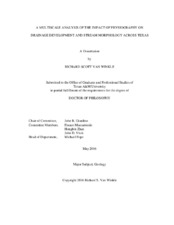| dc.description.abstract | Geomorphologists have been attempting to accurately classify streams for over a hundred years with varying success. Prior classification systems have run the gamut of scale-dependent perspectives ranging from watershed to reach. Stream classification schemes have been based on stream ordering, stream pattern, erosion-transport-deposition reach systems, and reach pattern; unfortunately, none of these systems have received universal acceptance.
Texas currently does not have a stream classification system based on Texas streams; thus, geomorphologists, water managers, and engineers can potentially misclassify streams based on classification systems developed for other regions. Using classifications created for other types of topography becomes ever more suspect because Texas has a highly diverse landscape consisting of nine distinct physiographic regions, each with variable lithology, land-use, soils, topography, and weather patterns and climate, making classification difficult and challenging. To fill this knowledge gap, a multiscale analysis was performed to determine the impact of physiography on drainage development and stream morphology. The challenge was to develop a stream classification system specifically for the rivers of Texas.
Using remote sensing and Geographic Information Systems, along with multivariate statistical analyses, a multiscale analysis was performed to determine the impact of physiography and weather on drainage basin development, stream sinuosity, and channel geomorphic units on the nine physiographic provinces of Texas. Principle component analysis and stepwise regression analysis showed that although multiple significant relationships were identified within the 121 basins studied, the basins tended to be more similar than different, making a unique classification system difficult.
Likewise, although significant statistical differences exist for stream sinuosity within the physiographic regions, the range of sinuosity values were large and overlapped province to province, thus making it difficult to categorize streams based on sinuosity.
Lastly, points bars, cut banks, longitudinal bars, tributary mouth bars and exposed bedrock were visually identified using high-resolution aerial photographs to recognize patterns of forms within the physiographic provinces. All of the geomorphic units for the study, with the exception of exposed bedrock, were found to form in all of the provinces. Overall, topographic influences, such as those from slope, relief, and elevation, tended to have the most impact at all scales. These results suggest that despite the differences in physical characteristics found within each of the provinces, the processes that affect basin development, stream morphology, and channel forms are more similar than initially hypothesized. Based on these results, a stream classification based solely on physiographic province would not suffice as an accurate and meaningful classification system for rivers in Texas. | en |


